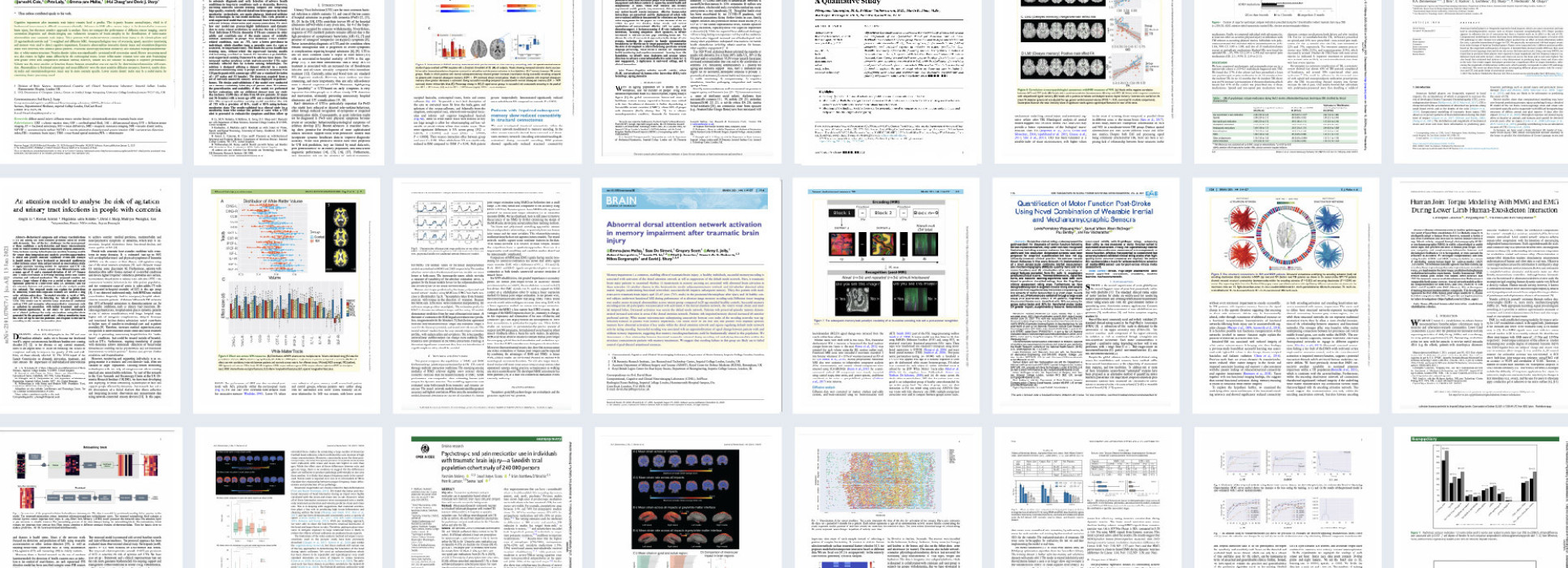
Results
- Showing results for:
- Reset all filters
Search results
-
Conference paperHan Y, Lauteslager T, Lande TS, et al., 2019,
UWB radar for non-contact heart rate variability monitoring and mental state classification.
, Annual Meeting of the IEEE Engineering in Medicine and Biology Society, Pages: 6578-6582, ISSN: 1557-170XHeart rate variability (HRV), as measured by ultra-wideband (UWB) radar, enables contactless monitoring of physiological functioning in the human body. In the current study, we verified the reliability of HRV extraction from radar data, under limited transmitter power. In addition, we conducted a feasibility study of mental state classification from HRV data, measured using radar. Specifically, arctangent demodulation with calibration and low rank approximation have been used for radar signal pre-processing. An adaptive continuous wavelet filter and moving average filter were utilized for HRV extraction. For the mental state classification task, performance of support vector machine, k-nearest neighbors and random forest classifiers have been compared. The developed system has been validated on human participants, with 10 participants for HRV extraction, and three participants for the proof-of-concept mental state classification study. The results of HRV extraction demonstrate the reliability of time-domain parameter extraction from radar data. However, frequency-domain HRV parameters proved to be unreliable under low SNR. The best average overall mental state classification accuracy achieved was 82.34%, which has important implications for the feasibility of mental health monitoring using UWB radar.
-
Journal articleLauteslager T, Tommer M, Lande TS, et al., 2019,
Coherent UWB radar-on-chip for in-body measurement of cardiovascular dynamics
, IEEE Transactions on Biomedical Circuits and Systems, Vol: 13, Pages: 814-824, ISSN: 1932-4545Coherent ultra-wideband (UWB) radar-on-chip technology shows great promise for developing portable and low-cost medical imaging and monitoring devices. Particularly monitoring the mechanical functioning of the cardiovascular system is of interest, due to the ability of radar systems to track sub-mm motion inside the body at a high speed. For imaging applications, UWB radar systems are required, but there are still significant challenges with in-body sensing using low-power microwave equipment and wideband signals. Recently it was shown for the first time, on a single subject, that the arterial pulse wave can be measured at various locations in the body, using coherent UWB radar-on-chip technology. The current work provides more substantial evidence, in the form of new measurements and improved methods, to demonstrate that cardiovascular dynamics can be measured using radar-on-chip. Results across four participants were found to be robust and repeatable. Cardiovascular signals were recorded using radar-on-chip systems and electrocardiography (ECG). Through ECG-aligned averaging, the arterial pulse wave could be measured at a number of locations in the body. Pulse arrival time could be determined with high precision, and blood pressure pulse wave propagation through different arteries was demonstrated. In addition, cardiac dynamics were measured from the chest. This work serves as a first step in developing a portable and low-cost device for long-term monitoring of the cardiovascular system, and provides the fundamentals necessary for developing UWB radar-on-chip imaging systems.
-
Journal articleGorgoraptis N, Zaw-Linn J, Feeney C, et al., 2019,
Cognitive impairment and health- related quality of life following traumatic brain injury
, Journal of Alzheimer's Disease, Vol: 44, Pages: 321-331, ISSN: 1387-2877BACKGROUNDCognitive impairment is a common and disabling consequence of traumatic brain injury (TBI) but its impact on health-related quality of life is not well understood.OBJECTIVETo investigate the relationship between cognitive impairment and health-related quality of life (HRQoL) after TBI.METHODSRetrospective, cross-sectional study of a specialist TBI outpatient clinic patient sample. Outcome measures: Addenbrooke's Cognitive Examination Tool - Revised (ACE-R), and SF-36 quality of life, Beck Depression Inventory II (BDI-II), Pittsburgh Sleep Quality Index (PSQI) and Epworth Sleepiness Scale (ESS) questionnaires.RESULTS240 adults were assessed: n = 172 (71.7% ) moderate-severe, 41 (23.8% ) mild, 27 (11.3% ) symptomatic TBI, 174 (72.5% ) male, median age (range): 44 (22-91) years. TBI patients reported poorer scores on all domains of SF-36 compared to age-matched UK normative data. Cognitively impaired patients reported poorer HRQoL on the physical, social role and emotional role functioning, and mental health domains. Cognitive impairment predicted poorer HRQoL on the social and emotional role functioning domains, independently of depressive symptoms, sleep disturbance, daytime sleepiness and TBI severity. Mediation analysis revealed that the effect of depressive symptoms on the emotional role functioning domain of HRQoL was partially mediated by cognitive dysfunction.CONCLUSIONCognitive impairment is associated with worse health-related quality of life after TBI and partially mediates the effect of depressive symptoms on emotional role functioning.
-
Conference paperAhmadi N, Cavuto ML, Feng P, et al., 2019,
Towards a distributed, chronically-implantable neural interface
, 9th IEEE/EMBS International Conference on Neural Engineering (NER), Publisher: IEEE, Pages: 719-724, ISSN: 1948-3546We present a platform technology encompassing a family of innovations that together aim to tackle key challenges with existing implantable brain machine interfaces. The ENGINI (Empowering Next Generation Implantable Neural Interfaces) platform utilizes a 3-tier network (external processor, cranial transponder, intracortical probes) to inductively couple power to, and communicate data from, a distributed array of freely-floating mm-scale probes. Novel features integrated into each probe include: (1) an array of niobium microwires for observing local field potentials (LFPs) along the cortical column; (2) ultra-low power instrumentation for signal acquisition and data reduction; (3) an autonomous, self-calibrating wireless transceiver for receiving power and transmitting data; and (4) a hermetically-sealed micropackage suitable for chronic use. We are additionally engineering a surgical tool, to facilitate manual and robot-assisted insertion, within a streamlined neurosurgical workflow. Ongoing work is focused on system integration and preclinical testing.
-
Journal articleEnshaeifar S, Zoha A, Skillman S, et al., 2019,
Machine learning methods for detecting urinary tract infection and analysing daily living activities in people with dementia
, PLoS One, Vol: 14, ISSN: 1932-6203Dementia is a neurological and cognitive condition that affects millions of people around the world. At any given time in the United Kingdom, 1 in 4 hospital beds are occupied by a person with dementia, while about 22% of these hospital admissions are due to preventable causes. In this paper we discuss using Internet of Things (IoT) technologies and in-home sensory devices in combination with machine learning techniques to monitor health and well-being of people with dementia. This will allow us to provide more effective and preventative care and reduce preventable hospital admissions. One of the unique aspects of this work is combining environmental data with physiological data collected via low cost in-home sensory devices to extract actionable information regarding the health and well-being of people with dementia in their own home environment. We have worked with clinicians to design our machine learning algorithms where we focused on developing solutions for real-world settings. In our solutions, we avoid generating too many alerts/alarms to prevent increasing the monitoring and support workload. We have designed an algorithm to detect Urinary Tract Infections (UTI) which is one of the top five reasons of hospital admissions for people with dementia (around 9% of hospital admissions for people with dementia in the UK). To develop the UTI detection algorithm, we have used a Non-negative Matrix Factorisation (NMF) technique to extract latent factors from raw observation and use them for clustering and identifying the possible UTI cases. In addition, we have designed an algorithm for detecting changes in activity patterns to identify early symptoms of cognitive decline or health decline in order to provide personalised and preventative care services. For this purpose, we have used an Isolation Forest (iForest) technique to create a holistic view of the daily activity patterns. This paper describes the algorithms and discusses the evaluation of the work using a lar
This data is extracted from the Web of Science and reproduced under a licence from Thomson Reuters. You may not copy or re-distribute this data in whole or in part without the written consent of the Science business of Thomson Reuters.
Awards
- Finalist: Best Paper - IEEE Transactions on Mechatronics (awarded June 2021)
- Finalist: IEEE Transactions on Mechatronics; 1 of 5 finalists for Best Paper in Journal
- Winner: UK Institute of Mechanical Engineers (IMECHE) Healthcare Technologies Early Career Award (awarded June 2021): Awarded to Maria Lima (UKDRI CR&T PhD candidate)
- Winner: Sony Start-up Acceleration Program (awarded May 2021): Spinout company Serg Tech awarded (1 of 4 companies in all of Europe) a place in Sony corporation start-up boot camp
- “An Extended Complementary Filter for Full-Body MARG Orientation Estimation” (CR&T authors: S Wilson, R Vaidyanathan)

Established in 2017 by its principal funder the Medical Research Council, in partnership with Alzheimer's Society and Alzheimer’s Research UK, The UK Dementia Research Institute (UK DRI) is the UK’s leading biomedical research institute dedicated to neurodegenerative diseases.


